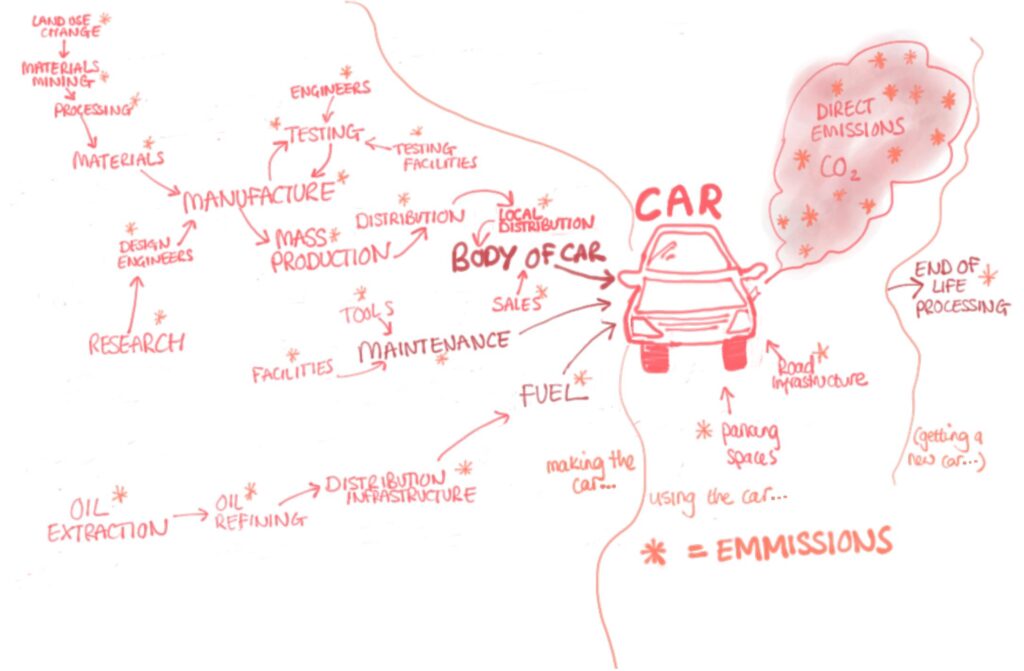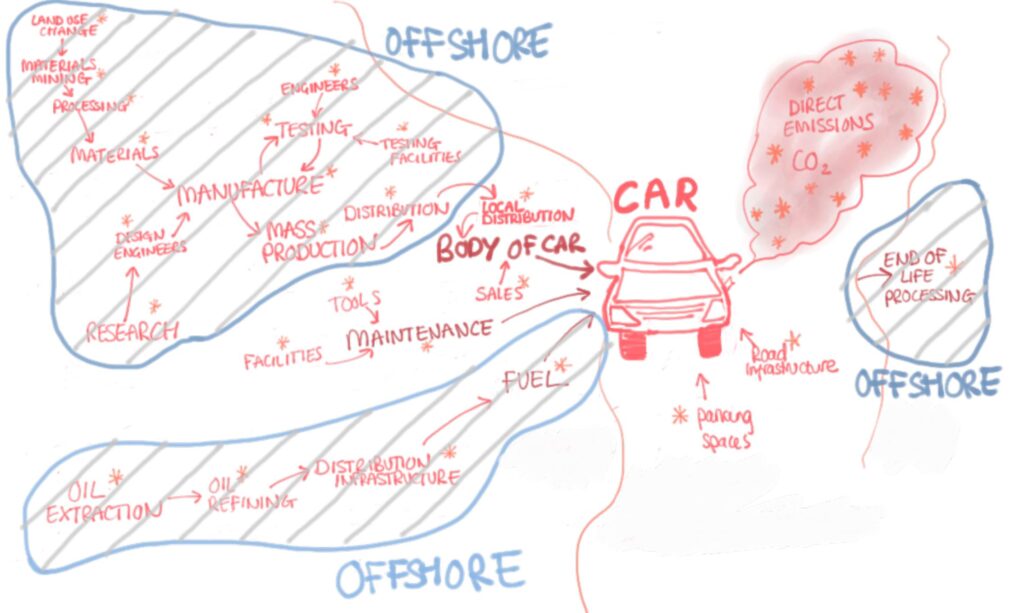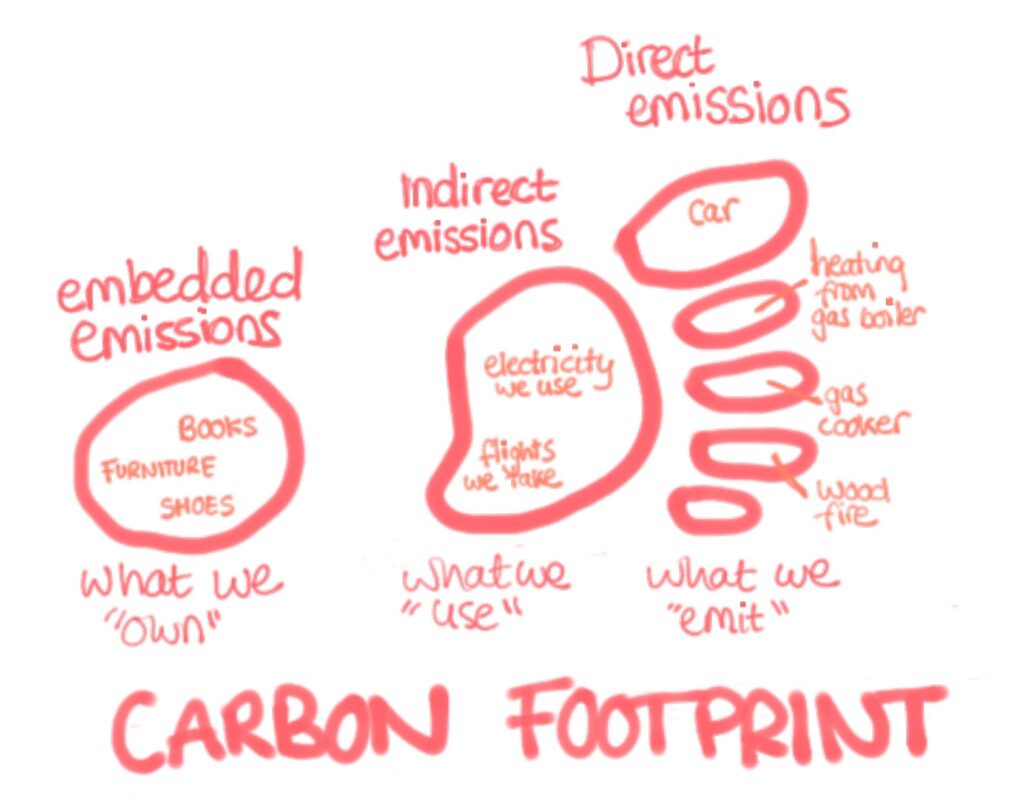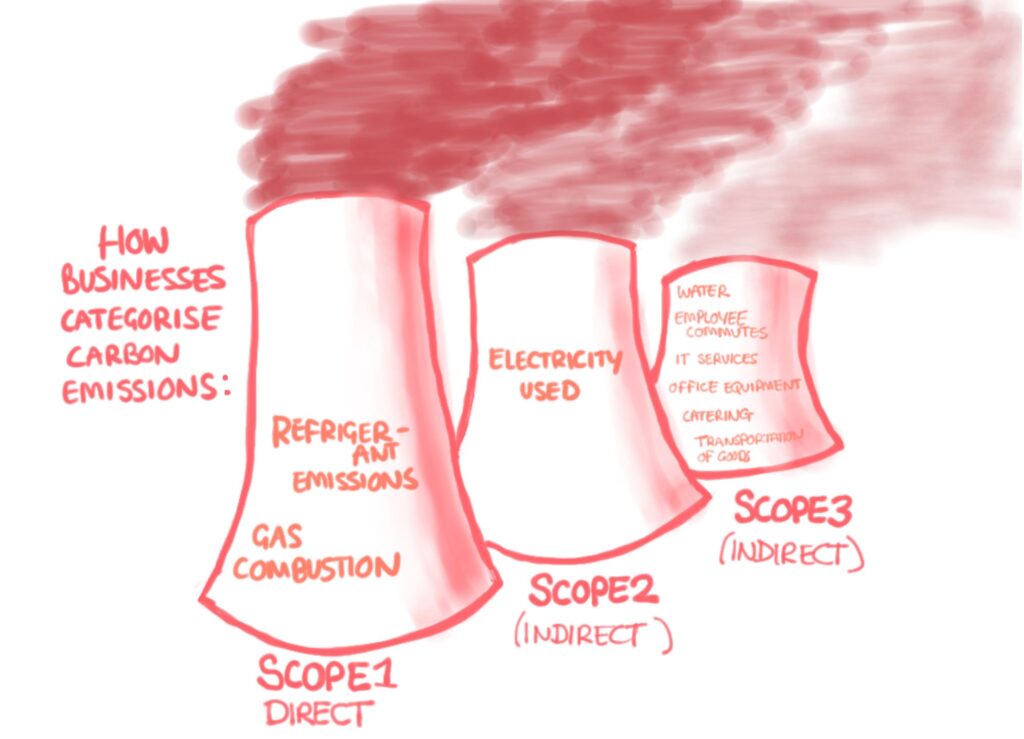How are carbon footprints different to carbon emissions? This post looks at what carbon footprint means and how these things are categorised.
As we go about our daily lives we are releasing fossil fuels into the environment. Sometimes we do this directly and sometimes we do it indirectly. When GHG emissions are deeply embedded into the things we do every day, it can be hard to tell who is responsible for what (and therefore who is responsible for reducing the emissions!). This goes between individual consumers like you and me to whole countries shifting emissions on each other.
If we are importing electricity from France, are we responsible for the emissions in making the electricity or are they? If someone take a business flight abroad to sort out a finance problem, is the individual responsibel for the emissions, orshould it be the company or the finance institution instead?
We are responsible for the emissions that come out of our car- that seems understood. However, are we also responsible for the embedded emissions in the actual car when making a car purchase decision? Or should the embedded emissions in a car be the responsibility of someone else?
This post looks at 3 things:
- Where do all the embedded emissions in “stuff” come from?
- What is a carbon footprint?
- How does industry categorise emissions?
What do the embedded emissions in “stuff” look like?
For every thing we come into contact with, there is a large chain of processes that will have gotten it there. These large chains have a carbon footprint. Take something simple like a car. We know driving cars has emissions because cars run on either petrol or diesel. As these burn, they release carbon dioxide into the atmosphere (a direct emission). But there are also emissions in mining the metals that make up the body of the car. There are emissions in making the plastics for the car interior. There are emissions from the offices designing the cars; computers, air con., catering, employee commutes and things like that. There are emissions from the factories where the cars are tested and prototypes and again when the cars are mass produced. Each time there are factory emissions in the buildings themselves and of the workers, their staff rooms, their uniforms etc.
There are also emissions from getting to fuel from out of the ground to the petrol station before it even goes in your car. There’ll be office emissions from geotechnical engineers investigating potential oil wells. There’ll be emissions in oil extraction (often offshore on huge rigs), oil refining and transportation.
Then there’s additional emissions in ‘use’ of the car such as road infrastructure. And lastly there’s end of life processing. Where parts are recycled or not the processing with be energy intensive.

Since making a car is often a multi company, multi-stage, multi-national process, It’s often useful for countries reporting their carbon emissions or carbon footprint to only focus on what has been done in their country. This makes the number lower than it actually is. Even if a car is produced for UK market demand, countries can ‘offshore’ the emissions of most of the process in their book keeping. I’ve sketched this in the picture below.

What is a carbon footprint?
There is a nice imager of the footprint that I first saw in a book called how bad are bananas by Mike Berners-Lee. The book calculates the carbon footprint of basically everything.
I’ve developed it a little further here to show you. Imagine the personal impact of your life in terms of carbon. The emissions you produce directly are the ‘toe-print’ of your overall carbon ‘foot-print’. The emissions generated from the services you use (such as a flight you might take, or electricity you might use) are the ball of the foot. Carbon calculators often only use these two metrics. But there is also the heel. It’s the collection of things you own; clothes, kitchen dish sets, plush carpets etc. and all the emissions associated with making them and eventually disposing of them.

If you’re interested in your own carbon footprint, here are links to 2 sites you can look at. Firstly there’s the WWF carbon footprint calculator. Second, there’s the how bad are bananas site. I’ll have another post on these and what to take from them out soon.
How do companies categorise emissions?
Our carbon footprint is what we “emit”, what we “use” and what we “own”.
When you read government report and industrial carbon impact assessments you’ll hear them talking about scope 1, scope 2 and scope 3 emissions. In a similar way to the footprint, scope 1 is ‘direct emissions’ and scope 2 is ‘indirect emissions’ from the electricity used. Scope 3 is all other indirect emissions a company might be responsible for such as IT services, offices and office equipment, the commutes of their employees.

Companies use these structures when trying to calculate their carbon emissions. There’s no legal obligation to but this is the framework advised and understanding the three scopes helps make sense of what and what isn’t being reported.
Conclusions
These carbon footprints exist whether we know about it or not. Learning and thinking them draws attention to the millions of processes that create our lifestyles. When I get into a car- I never think about the millions of miles the seat fabric has travelled or the commute the test engineers in japan may have had. Recognising these things in the first instance is humbling and a reminder that we’re pretty lucky. These thoughts make the idea of cutting down the clothes I buy, or paying a bit more for a train ticket than a flight much more acceptable in the grand scheme. I don’t see personal carbon footprint as the way to save the planet- but for all the people who are in a position to ever read this post- yeah, we need to humbly respect our planet and take some responsibility for the chains of services we use.
It’s also inspiring- look at the complexity in the services and products we use. If we can do all that- we can work together to create incredible things. And every single persons resolve and attitude is one step closer to getting there.
Thanks for reading! please get in touch in the comments to let me know you’re here and any thoughts.
Also, have you read my environment post basics of climate change?
